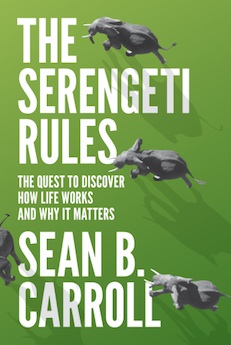Shortlisted for the 2017 Book Award in Science
By David L. Kirchman
The Serengeti Rules opens with the author and his family traveling on a gravel road to the Serengeti National Park in Tanzania, wondering where all the animals are. They know they have arrived when they see a lion and a bit later thousands of zebras. It’s his love of wildlife and concern for our planet that motivates Carroll to visit the park and to write this book, far from the turf of his day job as a professor in molecular biology at the University of Wisconsin-Madison. By the end of the introduction, it is clear that he has his sights on bigger game than just lions and zebras. He asserts that the rules that govern lions and zebras in the Serengeti are also those governing wolves in Yellowstone National Park, sea urchins in tidal pools of the Pacific Northwest, and cancerous cells in the human body.
Those rules are about regulations. Carroll ingeniously traces out how work by Jacques Monod on the regulation of enzymes in a bacterium led to the design of the drug, Gleevec, for fighting a type of cancer in humans. The disease happens when the rules are broken; critical genes aren’t regulated, and cells proliferate out of control. Gleevec works by restoring regulatory mechanisms directed by “tumor suppressor genes,” which normally prevent cell proliferation and cancer. He says that a detailed understanding of these mechanisms has led to drugs that specifically target tumors, replacing previous treatments that indiscriminately kill cancerous and healthy cells alike.
Carroll says the same rules of regulation apply to ecosystems. Rather than tumor suppressor genes, ecosystems have “keystone predators” that keep prey in check and the system in balance. First demonstrated for sea urchins in tidal pools, the keystone predator concept was put to the test in 1995 by the re-introduction of wolves to Yellowstone National Park. The last wolf there was killed in 1926. The thirty-one wolves released into the park multiplied to 301 within 10 years and cut the elk herd in half. With grazing by elk greatly diminished, aspen, willow, and cottonwood rebounded to the benefit of beavers and other animals. Numbers of pronghorn antelopes also increased because their predators, coyotes, were cut back by the resurgence of their natural enemy, the wolf. As with all of the examples in the book, this tinkering with nature has a happy ending because a keystone predator and other animals were returned to their natural places in the food chain.
Carroll explains the Serengeti rules and the biology behind them through fascinating stories of the people who did the work. The stories bring the scientists to life and in some cases reveal them to be larger than life. Monod, for example, rose to the rank of Commandant in the French Resistance and helped to coordinate in August 1944 the liberation of Paris from the Nazi occupation even as he continued to work in the lab on his bacterium. That work eventually would win him a Nobel Prize in 1965. More importantly, Carroll uses the stories to tell us how the science was done and the Serengeti rules figured out. The stories are told with a light touch and amused tone. The result is a delightful, thought-provoking book.
Carroll ends with an admonition and a note of cautious optimism. Just as understanding the Serengeti rules has led to new anti-cancer drugs, Carroll says we need to understand these rules for ecosystems in order to correct the many environmental problems now facing society. He thinks we can do it, maybe. Carroll points to the eradication of small pox as an example of society coming together to accomplish the seemingly impossible. However, too many environmental problems, climate change being the most obvious, are more complicated than a disease, even one as deadly and ageless as small pox, and more daunting to solve. Still, we can only hope that Carroll is right.
David L. Kirchman (ΦBK, Lawrence University, 1976) is the Maxwell P. and Mildred H. Harrington Professor Marine Biosciences at the University of Delaware and a resident member of the Alpha of Delaware chapter of Phi Beta Kappa.
Sean B. Carroll (ΦBK, Washington University, 1980) is a biologist, author, educator, and executive producer. His book The Making of the Fittest won the 2007 Phi Beta Kappa Book Award in Science.




